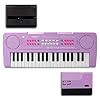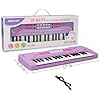Table of Contents
How to Build Speed and Accuracy on the Piano
Mastering the piano requires not only a deep understanding of music theory and composition but also a high degree of technical skill. For many pianists, developing speed and accuracy is crucial for performance and personal satisfaction. This introduction explores effective strategies and exercises designed to enhance these crucial skills. Whether you’re a beginner looking to lay a solid foundation or an advanced player aiming to polish your technique, focusing on speed and accuracy can greatly improve your musical capabilities and confidence.
1. Scale and Arpeggio Practice
Practicing scales and arpeggios is essential for developing dexterity and speed. Start slowly, ensuring that each note is played cleanly and with even pressure. Gradually increase the tempo as you become more comfortable. Use a metronome to keep your timing accurate and to challenge yourself to play faster over time.
Best Choice Products 61-Key Electronic Keyboard Piano Portable Electric Keyboard Complete Beginner Set w/LED Screen, Stand, Bench, Headphones - Black
13% OffRockJam 61 Key Keyboard Piano Stand With Pitch Bend Kit, Piano Bench, Headphones, Simply Piano App & Keynote Stickers
$129.99 (as of December 20, 2025 13:23 GMT -08:00 - More infoProduct prices and availability are accurate as of the date/time indicated and are subject to change. Any price and availability information displayed on [relevant Amazon Site(s), as applicable] at the time of purchase will apply to the purchase of this product.)Piano Star
$0.00 (as of December 20, 2025 13:23 GMT -08:00 - More infoProduct prices and availability are accurate as of the date/time indicated and are subject to change. Any price and availability information displayed on [relevant Amazon Site(s), as applicable] at the time of purchase will apply to the purchase of this product.)Keyboard Piano for Kids, BIGFUN 37 Keys Toddler Piano Multifunction Music Educational Instrument Toy, Electronic Kids Keyboard for 3-7 Year Old Girls and Boys (Purple)
15% Off2. Finger Independence Exercises
Finger independence exercises help to strengthen each finger and improve control. One popular exercise is to practice pressing down one finger at a time onto a surface while keeping the other fingers still and relaxed. This can also be practiced on the piano keys, holding one key down while playing notes with the other fingers.
3. Hanon Exercises
The Hanon exercises are specifically designed to improve piano technique, speed, and finger strength. Begin with the first exercises in the book and gradually work through to the more complex patterns. Consistency and gradual increase in tempo are key to making the most of Hanon exercises.
4. Rhythmic Variations
Practicing passages with different rhythmic variations can significantly enhance your finger speed and accuracy. For instance, if a passage is straight eighths, try playing it with dotted rhythms or as triplets. This not only makes practice more interesting but also improves rhythmic agility and precision.
5. Finger Staccato
Practicing staccato playing helps develop lightness and speed in finger movements. When playing staccato, focus on quick and controlled finger lifts, which is crucial for playing fast passages cleanly. This technique is not just about playing shorter notes, but involves precise control of finger muscles.
RockJam RJ761 61 Key Keyboard Piano with Keyboard Bench, Digital Piano Stool, Sustain Pedal, Headphones & Lessons
$159.85 (as of December 20, 2025 22:54 GMT -08:00 - More infoProduct prices and availability are accurate as of the date/time indicated and are subject to change. Any price and availability information displayed on [relevant Amazon Site(s), as applicable] at the time of purchase will apply to the purchase of this product.)Donner DDP-300 Digital Piano with 88 Graded Hammer Action Weighted Keys, Record, Bluetooth, 10 Voices, 4 Reverb, Speakers, Professional Full Fize Key Keyboard Electric Dark Rose
17% OffDonner DEP-20 Beginner Digital Piano 88 Key Full Size Weighted Keyboard, Portable Electric Piano with Furniture Stand, 3-Pedal Unit
15% OffYAMAHA P71 88-Key Weighted Action Digital Piano with Sustain Pedal and Power Supply (Amazon-Exclusive)
6% Off6. Utilizing Gravity and Weight Transfer
Effective use of gravity and transferring weight from one finger to another can aid in playing with less effort and greater speed. Practice transferring weight smoothly across your fingers, allowing gravity to help press the keys rather than relying solely on finger strength.
7. Blocking Techniques
Blocking involves practicing hand movements by playing groups of notes together as a single block or chord. This helps in understanding the layout of the notes in a passage and builds muscle memory. After practicing the blocking, play the notes rapidly one after another.
Practicing with a Metronome for Consistency
Utilizing a metronome in your practice sessions is crucial for developing consistent tempo and rhythm, which are essential components for achieving speed and accuracy on the piano. A metronome provides a steady beat that helps pianists internalize a consistent tempo. This practice also aids in developing muscle memory which is crucial for speed.
Start Slowly: Begin by setting the metronome to a slow, manageable tempo. Focus on playing each note clearly and correctly. This slow practice allows you to build the necessary muscle memory without introducing mistakes.
Gradual Increase: Once you can play the piece accurately at a slow tempo, gradually increase the metronome speed. Increment the tempo in small steps, ensuring at each step that you maintain precision and clarity in your playing.
Consistent Practice: Consistency in practice with a metronome cannot be overstated. Regularly practicing with a metronome will help you develop a strong sense of timing and rhythm, crucial for playing complex pieces where speed and accuracy are required.
Rhythmic Variation: To further enhance your skills, use the metronome to practice different rhythmic patterns. For example, if you are working on a piece with a lot of sixteenth notes, practice playing them as eighth notes or triplets against the metronome’s beat. This variation helps improve your rhythmic agility and precision.
Focused Sessions: Dedicate specific segments of your practice to using the metronome. While it’s beneficial to occasionally play pieces without the metronome to test your internal tempo, regular metronome use is essential for building lasting muscle memory and control.
In conclusion, the disciplined use of a metronome in your practice routine is invaluable in achieving speed and accuracy on the piano. By starting slow, gradually increasing speed, and maintaining consistent practice sessions, you’ll notice significant improvements in your playing precision and overall musical timing.
Breaking Down Complex Passages for Better Control
To enhance your piano playing skills, specifically your speed and accuracy, focusing on complex passages is crucial. This involves several strategic steps, which can lead to significant improvements in your performance.
Identifying Challenging Sections
The first step in breaking down complex passages is identifying the sections that are most challenging. This can be sections with fast note sequences, intricate rhythms, or awkward finger transitions. By isolating these areas, you can concentrate your practice where it’s needed most.
Slow Practice
Once challenging sections are identified, begin by practicing them slowly. Slow practice allows you to focus on accuracy and clarity of each note without the pressure of maintaining tempo. This method also helps in building muscle memory, ensuring that your fingers learn the exact movements required.
Hands Separately
Practice complex passages with each hand separately. This approach lets you concentrate on the technical demands of each hand without interference. For most pianists, the left hand often needs more attention due to its supporting role. Mastering each hand’s part before putting them together can dramatically improve overall performance.
Gradual Speed Increase
Once you are comfortable playing the passage slowly and with each hand separately, incrementally increase the tempo. Use a metronome to keep your pace steady and increase the speed only when you can play without mistakes. This controlled increase in speed helps build the motor skills necessary for playing at full tempo.
Using Different Rhythms
Applying different rhythms to the same notes can be a remarkably effective method for mastering tricky passages. By changing the rhythm, you essentially rewire your brain’s handling of the passage, making it easier to play in its original form. Practice the passage with dotted rhythms, swing rhythms, or even reverse the note values where feasible.
Fingering Consistency
Consistency in fingering is essential for playing complex passages accurately at high speeds. Ensure that you use the same fingering each time you practice a passage. Write the fingering into your music scores if necessary. Consistent fingering reduces hesitations and increases efficiency in movements.
Regular Review and Assessment
Regularly review your progress on these complex passages. Recording your practice sessions can help you monitor your accuracy and speed improvements. Assess whether the methods you’re employing are effective or if adjustments are needed. A feedback loop is critical for sustained improvement in any skill.
Exercises to Improve Precision in Playing
Scale and Arpeggio Drills: These fundamental exercises are crucial for dexterity and precision. Practice them with a metronome, gradually increasing the tempo without compromising the clarity of each note. Focus on evenness in finger strength and motion across both hands. Experiment with different articulations, such as staccato and legato, to enhance control and touch.
Hanon Exercises: The Virtuoso Pianist by Charles-Louis Hanon consists of sixty exercises designed to address weaknesses in finger independence and agility. Start slowly, emphasizing accuracy and evenness in rhythm. As you improve, increase the speed and incorporate variations in dynamics and rhythm to further challenge precision.
Czerny Exercises: Carl Czerny’s studies, especially Op. 299, Op. 740, and Op. 849, are excellent for developing speed, precision, and technique. Focus on one technical aspect with each exercise, such as jumps, rapid scale passages, or alternating hand motions. As with other exercises, use a metronome and incrementally increase the tempo while keeping your execution clean and accurate.
Polyrhythmic Studies: Playing different rhythms with each hand can profoundly enhance your coordination and timing. Start with simple rhythms, such as playing triplets in one hand against quarter notes in the other. Gradually progress to more complex patterns, ensuring both hands play precisely in their respective rhythms.
Metronome Use: Integrating metronome use in your practice routine can dramatically improve your rhythmic accuracy and control. Begin at a slower tempo where you can play notes accurately and with good quality, then gradually increase the pace as you maintain control and precision.
Sight-Reading Daily: Incorporating sight-reading into your practice sessions enhances your ability to play unfamiliar pieces with accuracy and confidence. Start with simpler pieces to build your skill and gradually tackle more complex compositions, focusing on playing correctly more than playing quickly.
Chord Inversions: Practice playing chords in various inversions across the keyboard. This exercise aids in understanding harmonic structures and improves hand positioning and transitions between chords. Focus on smooth execution and precise finger placement.
Rhythmic Variations: Altering the rhythm of pieces you are already familiar with can challenge your precision and adaptability. Apply dotted rhythms, swing rhythms, or syncopation to your scales, arpeggios, or pieces to make the practice more engaging and challenging.
Gradually Increasing Tempo Without Losing Accuracy
The key to developing both speed and accuracy in piano playing is to gradually increase your tempo without compromising the notes’ precision. This process involves several detailed steps, ensuring lasting results.
Begin by playing new pieces at a slow and comfortable pace. This allows you to focus on the correct notes and rhythms without feeling rushed. Starting slowly helps in building muscle memory with accuracy.
Introduce a metronome early in your practice. Start with a tempo at which you can play the piece perfectly, then gradually increase the metronome speed. For example, if you start at 60 beats per minute (BPM), increase to 65 BPM only when you feel fully comfortable and accurate at the current speed.
Make small incremental adjustments to the tempo. Increasing the speed by large amounts can overwhelm your abilities and cause mistakes. A good rule of thumb is increasing the tempo by no more than 3-5 BPM at a time.
Regular practice is crucial. Consistently playing a piece at increasing tempos reinforces muscle memory and strengthens finger independence and coordination, which are essential for both speed and accuracy.
Identify and isolate any difficult sections of the piece. Practice these passages slowly, then gradually increase the tempo for these sections alone. This targeted practice ensures that the challenging parts do not lag behind in speed or accuracy.
Continuously analyze your playing. If you notice consistent mistakes at higher tempos, reduce the speed to where you can play correctly. Only increase the tempo again once the errors are resolved. This step ensures that you do not reinforce mistakes.
Utilizing software and apps that help in tracking your progress can be helpful. These tools often provide features that allow you to listen to your performance and pinpoint areas that need improvement.
Ensure that your body, especially your hands and wrists, are relaxed. Tension can hinder the movement needed for playing fast and accurately. Regular breaks during practice sessions help maintain relaxation and focus.
Conclusion
Improving speed and accuracy at the piano hinges on consistent practice, proper finger technique, and gradual development. Regular practice sessions that focus on scales, arpeggios, and challenging passages can significantly enhance dexterity and precision. Employing metronome exercises ensures that you not only build speed but also maintain rhythmic accuracy. By meticulously dissecting pieces into manageable sections, focusing on finger strength, and remaining patient and persistent, pianists can achieve marked improvements in both speed and accuracy. Ultimately, the integration of these exercises into daily practice routines will lead to more fluid and confident piano playing.



























































